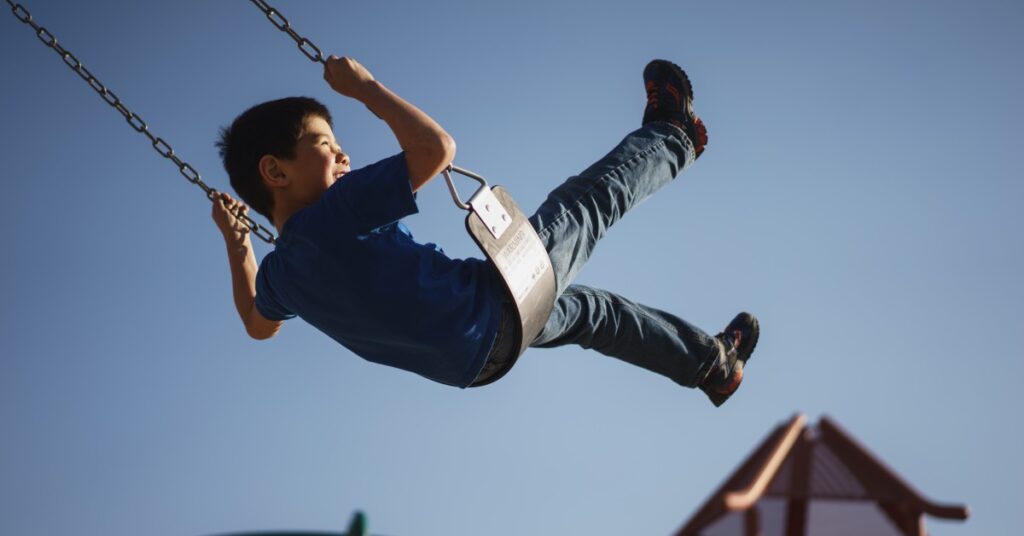
How Much Does a Doctor of Occupational Therapy Make?
In the occupational therapy field, a doctorate can open doors [...]

Occupational therapists (OTs, OTRs, or OTR/Ls—the extra letters are for registered/licensed) help adult patients with injuries, illnesses, or disabilities learn—or relearn—the kinds of activities of daily living that promote independence and confidence. Pediatric occupational therapists do similar work, but the techniques and tools they employ and their goals for their patients are often different. These OTs specialize in therapy services for young patients, typically prescribed occupational therapy because they need help reaching important physical, cognitive, or social milestones. With the aid of a pediatric OT, children of all ages can overcome developmental delays, learn and refine critical motor skills, and get on track for a healthy, independent adulthood.
In traditional occupational therapy, the goal of treatment is to give patients strategies and skills that let them care for themselves. Pediatric occupational therapy addresses a broader range of motor, sensory, visual, and behavioral concerns. It can involve everything from messy handwriting or a lack of focus to severe developmental disorders and physical differences.
The goals of pediatric therapy services are also quite broad. In some cases, pediatric OTs help correct minor motor issues that can impede self-esteem and confidence in kids. In others, they guide patients through activities designed to minimize the long-term impact of underlying physical and neurological conditions. Some pediatric OTs work exclusively with kids with autism spectrum disorders. In all cases, pediatric occupational therapy can be critical to a child’s well-being in the present and the future.
In this article, we answer the question what is pediatric occupational therapy? We discuss the following:
Pediatric occupational therapists work with all kinds of patients, just like other OTs. A pediatric occupational therapy patient may receive treatment after suffering an injury, having surgery, or even coping with a period of hospitalization or immobilization after a broken bone (both of which can result in developmental delays). Preemies often receive occupational therapy as part of early intervention to help them “catch up” to their full-term peers.
Pediatric OTs also work with children who have congenital conditions, sensory issues, behavioral issues, hearing and vision challenges, trouble speaking clearly, and balance issues. Generally, the challenges pediatric occupational therapy can address fall into seven categories:
Occupational therapy services for children are similar to those employed with OT for adults. Many pediatric occupational therapy sessions involve learning to do basic tasks like getting dressed, brushing teeth, and eating independently. When it comes to delays and behavioral issues, pediatric OTs have to look at their patients from a holistic perspective. It’s not enough to show kids strategies to overcome challenges. They need to find out where developmental delays or physical and cognitive limitations originate.
For instance, if a young patient is prescribed OT for issues related to visual-motor coordination, it’s not enough to teach them to catch a ball or hit a target with a dart. A pediatric occupational therapist takes into consideration whether that patient’s problems are related to a visual impairment, a neurological delay, or even something like ADHD or Asperger’s. Another patient might be prescribed occupational therapy because they have trouble self-regulating and act out. A pediatric OT provides alternative ways to deal with strong feelings while also looking into what other frustrations might be prompting negative behaviors.
Sometimes, occupational therapists who specialize in pediatrics will evaluate the need for special equipment. These can include dressing aids, walkers, or assistive communication devices when speech therapy isn’t an option.
The number one reason that pediatric occupational therapy exists as a specialty is that children simply learn differently. Pediatric OTs are experts in helping children gain strength and skills through exercises that feel like play.
Adults prescribed occupational therapy services after an injury or stroke typically want to get better as quickly as possible. They will gladly perform repetitive exercises because they have a goal in mind.
In contrast, kids get bored quickly if occupational therapy is too repetitive and frustrated if what they’re asked to do is too hard. They can also become anxious if OT feels too much like a visit to the doctor.
That’s why in pediatric occupational therapy, sessions are designed to be fun. The goal is to have young patients engaged from start to finish. Pediatric OTs incorporate play into their sessions and use tools like craft kits, paint, board games, puzzles, modeling clay, swings, tumbling mats, and even obstacle courses. An adult patient in occupational therapy recovering from hand surgery might have to pick up twenty coins during their session. A child recovering from the same surgery might play a board game with pieces that are roughly coin-shaped during theirs.
Every pediatric OT has their motivations for choosing this specialty. Even so, there are a few key ways in which pediatric occupational therapy is unique. When an OT works with babies or children, they’re working with patients at some of the most essential developmental stages. That means that the progress they make with those patients impactS their quality of life well into adulthood.
Pediatric occupational therapists also get to work with whole families and share in their joys. That was part of what attracted pediatric OT Katie Caspero to this specialty. “I love working with the whole family unit and seeing kids who have worked so hard on their goals finally meet them,” she told the OTPotential blog. “I love to share in their joy and smiles when they say, ‘Ms. Katie, I can tie my shoes!'”
Caspero also enjoys her work in pediatrics because every day is different. “I could be spending the morning working on feeding with a kid with autism,” she added, “then work with a child with cerebral palsy in the pool, and end the day working on dressing techniques with a child with a genetic disorder. It’s a great challenge and keeps things interesting!”
Many aspiring OTs major in biology, kinesiology, psychology, or sociology during their undergraduate years. There are a few pre-OT programs at schools like The University of Texas at Austin and the University of Colorado Boulder, but not many.
From there, all OTs need at least a Master of Occupational Therapy (MOT) to practice. Some aspiring occupational therapists opt for the entry-level Doctor of Occupational Therapy (OTD) instead. The Accreditation Council for Occupational Therapy Education (ACOTE) considered mandating that all entry-level occupational therapy programs transition to the doctoral level by 2027, but voted in favor of dual-degree levels for the time being.
There are some excellent reasons to consider the OTD over the MOT—not the least of which is the fact that ACOTE may very well pivot and mandate doctoral-level degrees for OTs in the future. OTD programs tend to cover more ground than MOT programs. Doctoral students take the same kinds of core classes in clinical methods that occupational therapy master’s degree students take, plus courses in program development and evaluation, medical practice management, applied research, and leadership.
At the University of Pittsburgh, students in the three-year, nine-term entry-level OTD program take courses like:
The most important certification in pediatric occupational therapy is probably the American Occupational Therapy Association‘s Certification in Pediatrics (BCP) credential. To earn this certification, OTs have to commit to ongoing professional development related to pediatric populations and to consistently improving outcomes for pediatric patients.
However, there are also many other certifications for occupational therapists, and many of them are relevant to pediatric occupational therapy. Pediatric OTs often pursue certifications like the:
Pediatric occupational therapists aren’t typically paid any more or less than OTs in other specialties. Occupational therapy jobs tend to pay well, with salaries between $70,000 and $100,000, and average pediatric occupational therapist salaries tend to fall into the same range. Salaries for all occupational therapists vary significantly by location, regardless of specialty, and practice setting also plays a role in the earning potential of pediatric OTs. A pediatric occupational therapist in private practice, for instance, typically earns about $94,000 a year.
Pediatric occupational therapy literally changes lives. Even a few sessions with an OT positively impact patients, not only in the present but also well into the future. That’s because the skills children learn with the help of pediatric OTs stay with them through adulthood. Pediatric occupational therapy helps children grow into more confident and more successful grownups. Not many healthcare professionals can measure the effects of their work over years.
It’s also fun! When student and future OT Lisa Griggs-Stapleton was investigating careers in healthcare, she was surprised by what she saw when observing an occupational therapy session. “The session wasn’t like any other healthcare I had seen. I was used to the idea that most people don’t like going to the therapist, but occupational therapy was different. People, especially children, enjoy the sessions and sometimes don’t want to leave. Occupational therapists have the privilege of helping people learn or relearn how to connect with their environment, and we get to have fun while we do it.”
Finally, there’s a lot of joy in pediatric occupational therapy. Children make great strides when working with occupational therapists. Pediatric OTs get to celebrate their successes with their patients’ families.
“I help a lot of families that have children with feeding issues, and they hold a special place in my heart,” pediatric OT Heidi Youstler shared with Washington University in St Louis on the school’s program website. “As parents, we want to provide the basic needs for our children. When these families discharge from the program and the child is eating well, it is such a joyous moment both for them and for me.”
(Last Updated on February 26, 2024)
Questions or feedback? Email editor@noodle.com

In the occupational therapy field, a doctorate can open doors [...]

Physical therapists are in high demand and the field is [...]

A master's degree is sufficient to practice occupational therapy,for now. [...]

Students in HBCU DPT programs often find their schools are [...]

Both PTs and OTs have crucial roles in helping people [...]
Categorized as: Occupational & Behavioral Therapy, Nursing & Healthcare